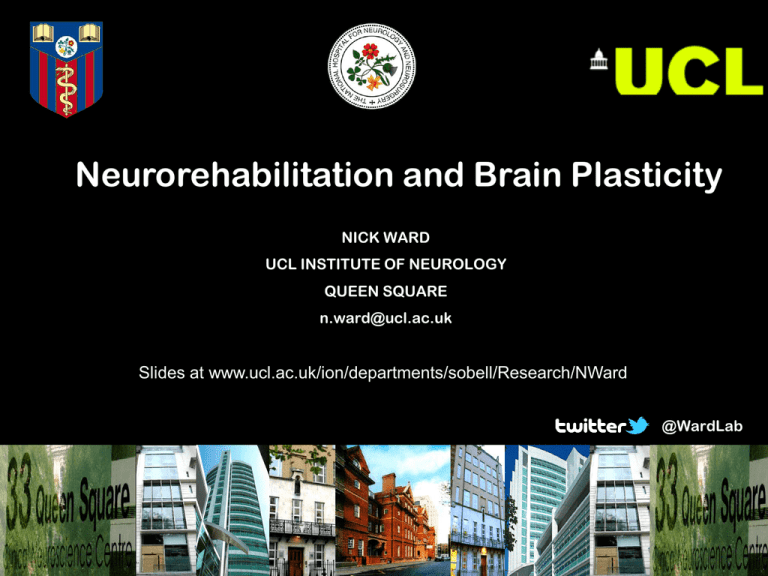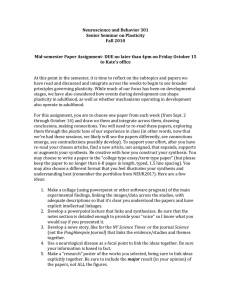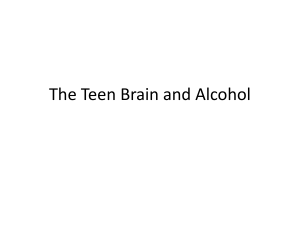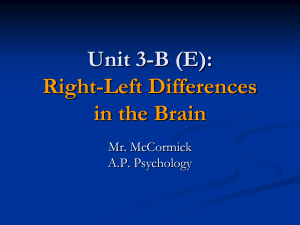Neurorehabilitation and Brain Plasticity Slides at www.ucl.ac.uk/ion/departments/sobell/Research/NWard NICK WARD UCL INSTITUTE OF NEUROLOGY
advertisement

Neurorehabilitation and Brain Plasticity NICK WARD UCL INSTITUTE OF NEUROLOGY QUEEN SQUARE n.ward@ucl.ac.uk Slides at www.ucl.ac.uk/ion/departments/sobell/Research/NWard @WardLab Brain imaging for neurorehabilitation after stroke Overview 1. What is plasticity? 2. How do we treat upper limb impairment? 3. Variability in lesion induced structure and organisation 4. Predicting outcomes? Rehabilitation & Plasticity Treating Stroke 1. 2. 3. 4. 5. Preservation of tissue Avoid complications Task specific training Enhancement of plasticity Compensation Rehabilitation Recovery Rehabilitation & Plasticity Treating Stroke Upper limb recovery after stroke is unacceptably poor • 60% of patients with non-functional arms 1 week post-stroke didn’t recover (Wade et al, 1983) • 18 months post-stroke 55% of patients had limited or no dextrous function (Welmer et al, 2008) • 4 years post-stroke only 50% had fair to good function (Broeks et al, 1999) Rehabilitation & Plasticity What is brain plasticity? PLASTICITY is • the formation of new functional connections between nerve cells • the withdrawal of inappropriate connections • the modulation of strength between the cell-cell connections called synapses changes that occur in the organization of the brain as a result of experience Rehabilitation & Plasticity What is brain plasticity? Activity takes advantage of plastic changes, but also enhances them These are therefore therapeutic targets for the promotion of recovery after stroke activity lesion induced changes inactivity Rehabilitation & Plasticity What is brain plasticity? Brain plasticity! Hold on ….. the cortex is not capable of plasticity but is hardwired and immutable. Once damage occurs, cortical neurons either die or at best do not change their projection patterns…..” Rehabilitation & Plasticity What is brain plasticity? Dendritic growth in vivo Axon arborisation in vivo Niell et al., Nat Neurosci 2004; 7: 254-260 Hua et al., Nature 2005; 434: 1022-1026 dendrites axon Rehabilitation & Plasticity What is brain plasticity? “…..the cortex is not capable of plasticity but is hardwired and immutable. Once damage occurred, cortical neurons either died or at best did not change their projection patterns…..” The structure of the brain is constantly changing – this is the basis of learning both in health and disease However, it requires ‘activity’ to take advantage of these processes and create new connections and networks Rehabilitation & Plasticity How do we treat upper limb impairment? Rehabilitation is a process of active change by which a person who has become disabled acquires the knowledge and skills needed for optimum physical, psychological and social function Treatments aimed at reducing impairments Task-specific training cortical stimulation other drugs Rehabilitation & Plasticity How do we treat upper limb impairment? Task specific training is better than general exercise – motor learning? Works better in patients with reasonable residual motor control Optimal dose is important but not clear Motor practice/ Motor learning Constraint induced therapy Robotic assisted devices Virtual environments Rehabilitation & Plasticity How do we treat upper limb impairment? Performance improvement proportional to amount of practice 1. Distributed practice - frequent and longer rest periods 2. Variable practice - varying parameters of task 3. Contextual interference - random ordering of related tasks Better retention and generalisation of learning to new tasks Krakauer JW. Motor learning: its relevance to stroke recovery and neurorehabilitation. Curr Opin Neurol 2006 19:84–90 Rehabilitation & Plasticity How do we treat upper limb impairment? • multi-site single blind randomized controlled trial • 4-week self-administered graded repetitive upper limb program in 103 stroke patients approx 3 weeks post stroke • 3 grades (mild, moderate, severe) • Provided with exercise book with instructions • Repetitions, inexpensive equipment • strength, range of motion, gross and fine motor skills • GRASP group showed greater improvement in upper limb function • GRASP group maintained this significant gain at 5 months post-stroke Rehabilitation & Plasticity How do we treat upper limb impairment? Rehabilitation & Plasticity How do we treat upper limb impairment? Robotic treadmill training Home video arm/hand training Robotic arm training Rehabilitation & Plasticity How do we treat upper limb impairment? Rehabilitation & Plasticity How do we treat upper limb impairment? www.camden.nhs.uk/gps/upper-limb-rehabilitation-clinic www.ucl.ac.uk/ion/departments/sobell/Research/NWard/patientsprofile/infoforpatients/upperlimbclinic Rehabilitation & Plasticity How do we treat upper limb impairment? Rehabilitation is a process of active change by which a person who has become disabled acquires the knowledge and skills needed for optimum physical, psychological and social function Treatments aimed at reducing impairments Task-specific training cortical stimulation other drugs Rehabilitation & Plasticity How do we treat upper limb impairment? Rehabilitation & Plasticity How do we treat upper limb impairment? Lancet Neurol 2011;10:123-30 • 118 patients with ischemic stroke and hemiparesis (Fugl-Meyer scores ≤55) • fluoxetine (n=59; 20 mg once per day, orally) or placebo (n=59) • 3 months starting 5 to 10 days after the onset of stroke • All patients had physiotherapy as delivered in local unit • The primary outcome measure was change in the FM score between day 0 and 90 Rehabilitation & Plasticity How do we treat upper limb impairment? Lancet Neurol 2011;10:123-30 less disability Improved FM score at 90 days more disability Improved mRS score at 90 days Rehabilitation & Plasticity How do we treat upper limb impairment? Rehabilitation is a process of active change by which a person who has become disabled acquires the knowledge and skills needed for optimum physical, psychological and social function Treatments aimed at reducing impairments Task-specific training cortical stimulation other drugs Rehabilitation & Plasticity Variability in lesion induced structure and organisation stroke damage damaged pathways cortical reorganisation? Rehabilitation & Plasticity Variability in lesion induced structure and organisation T1 structural DTI fMRI Rehabilitation & Plasticity Variability in lesion induced structure and organisation Track from fMRI-defined hand areas in 4 different cortical motor areas Schulz et al, Stroke 2012; 43:2248-51 Corrrelation with poststroke hand grip strength Rehabilitation & Plasticity Variability in lesion induced structure and organisation affected side A 10 days post stroke infarct B 17 days post stroke 24 days post stroke 31 days post stroke 3 months post stroke affected side OUTCOMES Barthel ARAT GRIP NHPT Patient A 20/20 57/57 98.7% 78.9% Patient B 20/20 57/57 64.2% 14.9% Rehabilitation & Plasticity Predicting outcomes unaffected + affected - unaffected + affected - Will the same treatment strategy work in these patients? Rehabilitation & Plasticity Predicting outcomes Stinear, C. M. et al. Brain 2007 130:170-180 Copyright restrictions may apply. Rehabilitation & Plasticity Predicting outcomes 1. SAFE = shoulder abduction + finger extension (MRC scale) 72 h after stroke (range 0–10) 2. TMS at 2 weeks Stinear, C. M. et al. Brain 2012 Aug;135:2527-35 Copyright restrictions may apply. 3. MRI/DTI at 2 weeks Rehabilitation & Plasticity Predicting outcomes 1. SAFE = shoulder abduction + finger extension (MRC scale) 72 h after stroke (range 0–10) 2. TMS at 2 weeks Stinear, C. M. et al. Brain 2012 Aug;135:2527-35 3. MRI/DTI at 2 weeks Rehabilitation & Plasticity Summary • Advances in neurorehabilitation are coming about through advances in neuroscience • The dose of treatment is critical - more is generally better • Enhancement of plasticity is possible • Neuroimaging should help in stratification • Understanding the mechanisms of recovery and treatment might allow targeted or individualised therapy after stroke in future Rehabilitation & Plasticity Acknowledgements FIL: ABIU/NRU: SOBELL DEPARTMENT : Richard Frackowiak Fran Brander Holly Rossiter Will Penny Kate Kelly Ella Clark Jennie Newton Diane Playford Sven Bestmann Alan Thompson John Rothwell Penny Talelli Slides at www.ucl.ac.uk/ion/departments/sobell/Research/NWard FUNDING:



